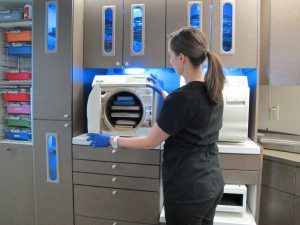- What Is Gum Disease?
- Gum Disease Symptoms
- What Is Biofilm?
- Gum Disease Prevention
- Diagnosing Gum Disease
- Stages of Gum Disease
- Curing Gum Disease
- Gum Disease Treatments
- Gum Therapy Cost
What Is Gum Disease?
Gum disease is a bacterial infection of the periodontal tissues that surround your teeth. The condition affects millions of Americans, and can be the cause of serious risks to your health if left untreated. In addition to major dental problems that can result from gum disease, it may also elevate the risk of heart disease, stroke, diabetes, and other severe conditions. Our Austin dentists offer a comprehensive range of treatment options that can prevent gum disease from getting worse and give the gums a healthier appearance. Austin Dental Spa is equipped with the latest dentistry technologies to aid our dentists in evaluating gum disease and providing you with precise, effective treatment.
What Are the Symptoms of Gum Disease?
Gum disease is typically caused by harmful bacteria invading the gums. This bacteria results from plaque that has built up along the teeth and gums. Even with regular brushing and flossing, small bits of plaque can still find its way into the gums and cause gingivitis, the least dangerous form of gum disease. Most people will be affected by gingivitis at some point, which is why we offer family dentistry options to ensure early treatment is available to stop gum disease from worsening. However, if treatment is not performed in the early stages of gingivitis, more serious gum disease can result, and that, in turn, can lead to overall health problems. This makes it vitally important to not only have routine dental checkups and teeth cleanings, but also to be aware of the symptoms of gum disease. Some of these symptoms include:
- Inflamed, red gums
- Pain or discomfort along the gumline
- Gums that easily bleed
- Spaces forming between the teeth
- Teeth that feel loose
- Tooth loss
What Is Biofilm?
Biofilm forms when bacteria adheres to surfaces, usually in a wet environment, and begin to excrete a sticky, glue-like substance that sticks to any surface, allowing more and more bacteria to adhere and organize into “colonies.” More common examples include clogged drains, clogged arteries, and the slimy film on your bathtub. In the human mouth, these biofilms form on the teeth surfaces and oral appliances like dentures, mouthguards, or orthodontic braces and retainers, creating a sticky yellow substance called “dental plaque.” In sufficient quantities, any of these bacterial colonies can lead to gum disease, starting with mild bleeding and swelling of the gum tissue and progressing to severe bone loss and loosening of the teeth
How Can I Prevent Gum Disease?
The best way to prevent gum disease is to practice good oral hygiene. This includes brushing at least twice every day, flossing once a day, and using mouthwash to further clean the mouth. In addition to these daily habits, you should visit your dentist for twice-yearly cleanings and exams, where they can remove plaque and tartar from your teeth, as well as monitor your oral health for the earliest signs of gum disease.
Since some people are more prone to developing gum disease, it also helps to be aware of your risk level. While some factors may be out of your control, such as age and genetics, certain lifestyle habits can minimize your risk of gum disease. These include refraining from smoking and eating a healthy diet.
How Is Gum Disease Diagnosed?
 At Austin Dental Spa, we utilize diagnostic technologies to precisely and effectively identify periodontal disease. By taking bacteria test samples from around your teeth, we can learn if pathogens are present at an early stage. It is these harmful pathogens that can put you at a higher risk of developing periodontal disease. Based on the diagnosis, your dentist can determine what type of therapy or antibiotic treatment is best. This early detection and treatment with laser dentistry can often be the most effective way patients can minimize damage from gum infections.
At Austin Dental Spa, we utilize diagnostic technologies to precisely and effectively identify periodontal disease. By taking bacteria test samples from around your teeth, we can learn if pathogens are present at an early stage. It is these harmful pathogens that can put you at a higher risk of developing periodontal disease. Based on the diagnosis, your dentist can determine what type of therapy or antibiotic treatment is best. This early detection and treatment with laser dentistry can often be the most effective way patients can minimize damage from gum infections.
What Are the Stages of Periodontal Disease?
When not treated early, gum disease has the chance to worsen into more severe forms. This results from bacteria that inflames your gums to eventually infect the gums and bone that support your teeth. The most effective method of treatment will ultimately depend on the stage of gum disease you have.
- Gingivitis: The earliest stage of gum disease, gingivitis is caused by a buildup of plaque at the gumline, which causes inflammation. If you suffer from gingivitis, you may notice some bleeding when you brush and floss.
- Periodontitis: As gingivitis worsens, a periodontal pocket forms below your gumline that traps bacteria. At this stage, the bone and connective fibers that support your teeth become damaged, which cannot be reversed but can be controlled.
- Advanced Periodontitis: At this most severe form of gum disease, the gum and fibers that hold your teeth have been significantly damaged, which may cause your teeth to become loose. As a result, your bite may be affected and teeth may need to be extracted.
Can Gum Disease Be Cured?
Gingivitis is the only form of gum disease that is considered reversible. If you notice early signs of this, such as your gums bleeding regularly, make sure to visit your dentist to learn if this may be caused by a gum infection and how you can treat the problem. Unfortunately, there is no cure for advanced gum disease, known as periodontitis; however, there are very effective treatments to stop it from causing more damage and relieve the symptoms. Our practice offers advanced techniques to help you address this very common condition.
What Are My Gum Disease Treatment Options?
Deep Cleaning and Root Planing
When gum disease is present, one of the most frequently performed and effective procedures to treat symptoms and prevent it from getting worse is deep scaling and root planing. This treatment is a non-surgical technique that removes the buildup of plaque and tartar along the teeth and root tissue. Deep scaling and root planing significantly reduces pockets of bacteria and stimulates the healing of the gums.
Antibiotic Therapy
Antibiotic therapy is often utilized to help patients keep their gum disease under control. Using our diagnostic system, we can determine the exact type of bacteria that is causing your gum disease. This involves taking a bacterial sample from your gums, which is then sent to a lab to be analyzed. Once the bacteria has been identified, he can recommend the most effective antibiotic treatment for your specific case.
Laser Dentistry
Laser dentistry can be highly beneficial for helping manage gum disease. Using our advanced Waterlase® MD technology, a focused beam of light energy is delivered to the target area to remove diseased tissue and sterilize the periodontal pockets where bacteria tend to thrive. This eliminates the harmful bacteria causing inflammation and helps prevent future buildup. As the laser energy is delivered to the affected gums, a steady stream of water is delivered to create a cooling effect. This process provides patients with a more comfortable procedure as well as an improved recovery with minimal bleeding and discomfort.
Perio Protect®
We are proud to offer superior dental care through the Perio Protect® Method. As a certified office for Perio Protect®, we are able to manage bacterial communities, also known as biofilm, growing between patients’ teeth and gums. The treatment involves standard dental cleaning procedures as well as chemical therapy between office visits. This therapy requires patients to wear a customized dental tray for a few minutes each day. It is filled with a chemical solution that removes biofilm, treats the infection, and prevents the bacterial regeneration. Overall, Perio Protect® proves to be an effective way to treat gum disease as well as prevent further damage from occurring.
How Much Does Gum Therapy Cost?
Periodontal care is a very individualized treatment process that will vary for every patient. As such, the total cost of your gum therapy will depend upon the type and extent of your gum condition. Once our dentists have had the opportunity to perform an oral evaluation, we will design a custom treatment plan to help improve your symptoms and prevent your gums from getting worse. Since gum disease cannot be cured, therapy is typically designed to manage the condition long-term and should not be viewed as a quick fix. After your oral assessment, our team will provide you with a quote for your initial gum therapy and can help you understand what to expect for the future of your care. If you have any questions or concerns, please don’t hesitate to reach out to us or ask your dentist during your appointment.
Contact Austin Dental Spa
Please contact Austin Dental Spa for more information on gum disease care, or to schedule an appointment here at our practice. Remember, early evaluation and treatment for periodontal issues are the keys to keeping your gums as healthy as possible!
